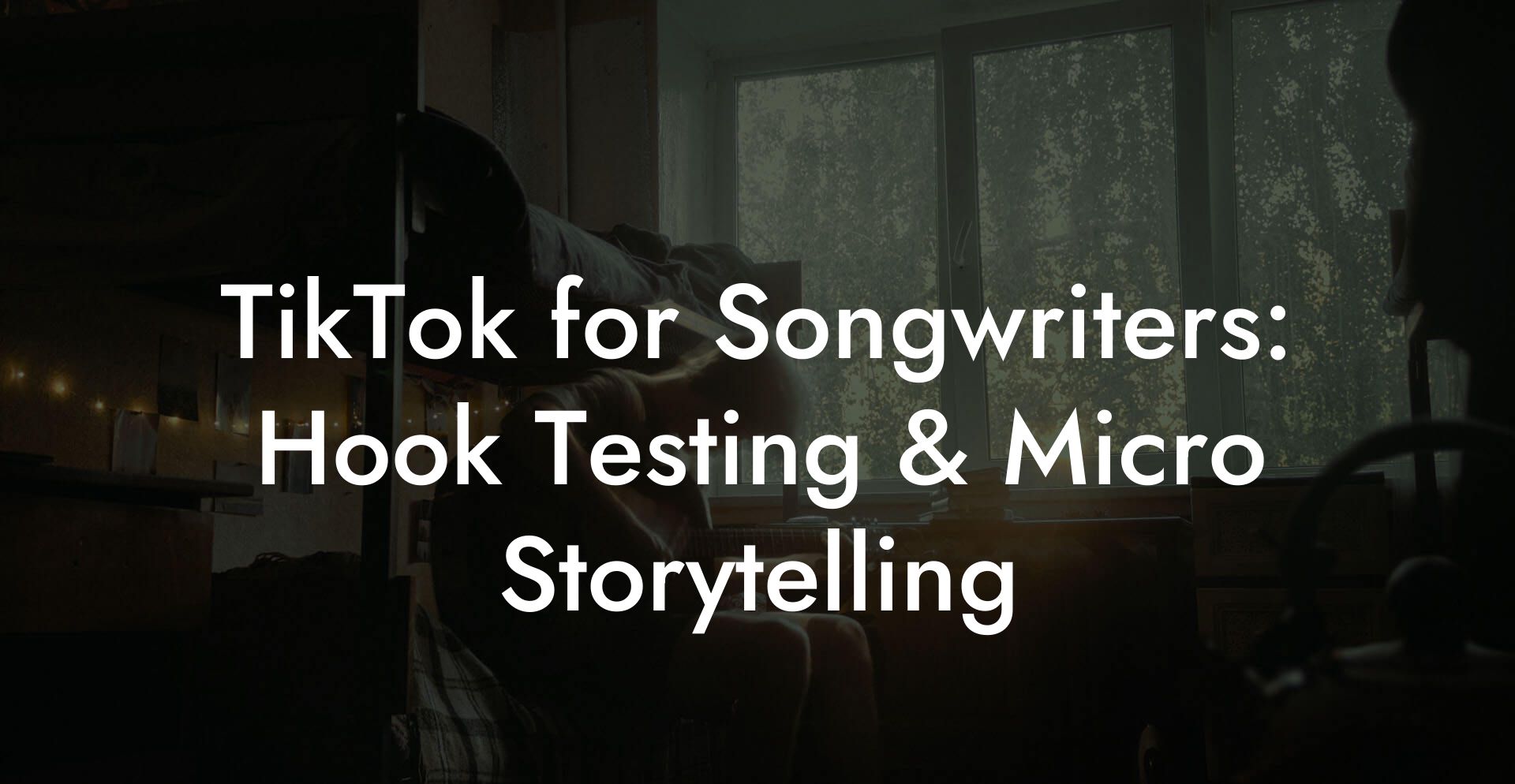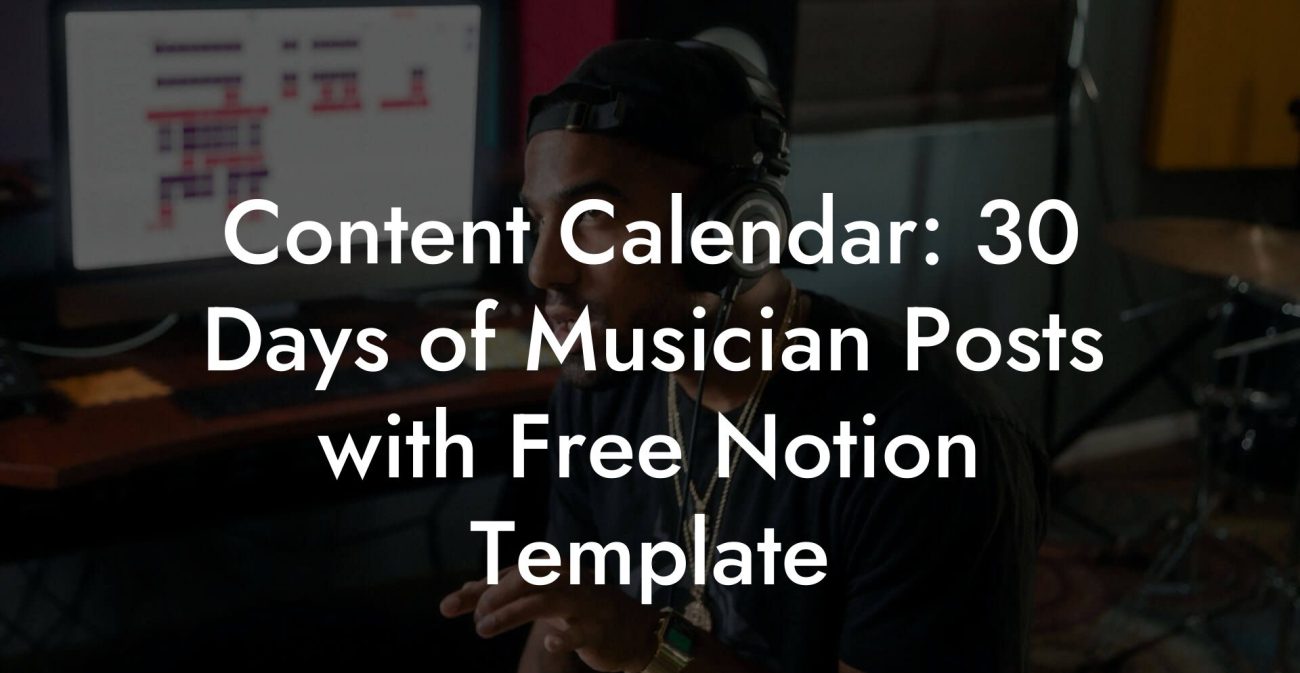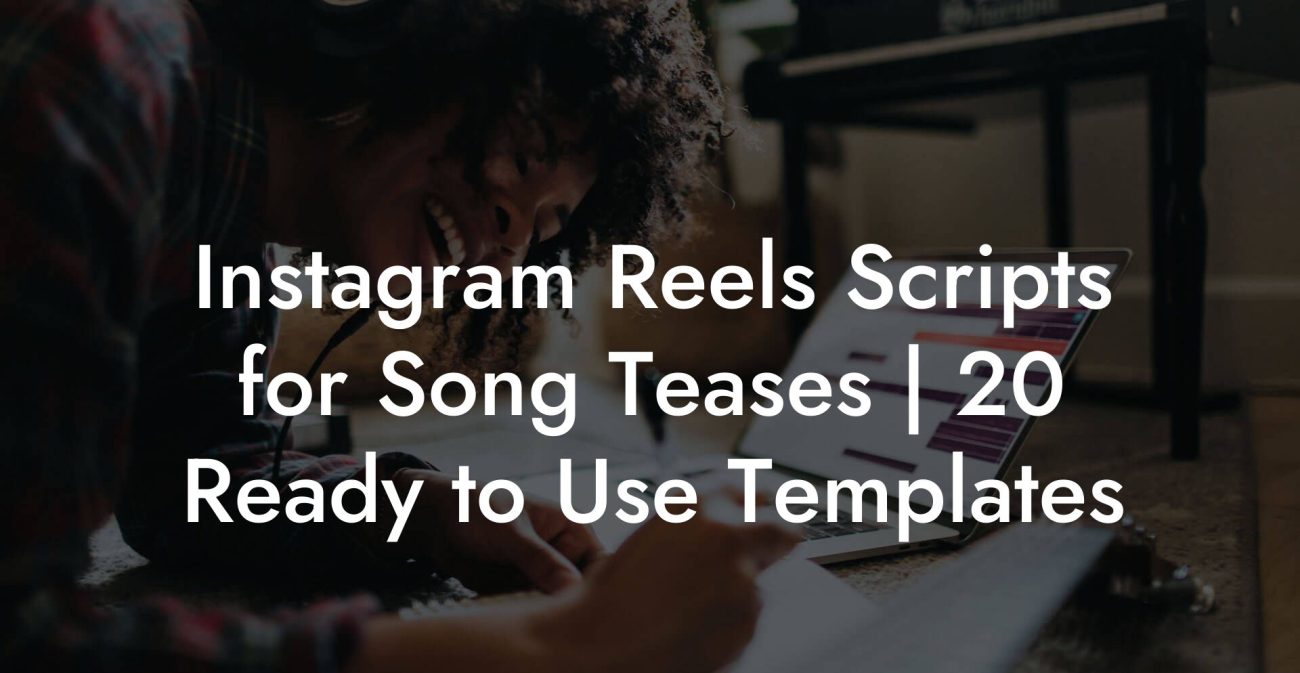Songwriting Advice
TikTok for Songwriters: Hook Testing & Micro Storytelling

Listen up. TikTok is not a nice to have anymore. It is auditioning your song every time someone scrolls. If your hook fails in the first three seconds the rest of the song does not get a chance to explain itself. This guide gives you a brutal friendly system to test hooks, build micro stories that convert listeners into fans, and read the small honest numbers that tell you what to do next.
Quick Interruption: Ever wondered how huge artists end up fighting for their own songs? The answer is in the fine print. Learn the lines that protect you. Own your masters. Keep royalties. Keep playing shows without moving back in with Mom. Find out more →
Quick Links to Useful Sections
- Why TikTok actually matters for songwriters
- Define the hook you want to test
- Real life scenario
- Metrics that matter for hook testing
- Hook testing framework
- Example experiment
- Micro storytelling for songwriters
- Problem then payoff
- Before and after
- Mini arc with surprise
- Three micro story templates you can steal
- Template 1 Emotional reveal
- Template 2 Relatable routine
- Template 3 POV confession
- Visuals and audio that sell the hook
- Original sound versus using trends
- Posting mechanics that amplify tests
- How to read analytics like a songwriter who wants to actually improve
- Numbers to look for
- Turn TikTok wins into streams and real fans
- Example follow funnel
- Common mistakes and what to do about them
- Tools and simple kit list
- Experiment calendar you can steal
- Examples of micro storytelling that work for songwriters
- Example 1
- Example 2
- Example 3
- Monetization paths you should consider
- Keeping sanity and avoiding burnout
- Frequently asked questions
This is written for busy songwriters who prefer blood, coffee, and results. I will explain every acronym and term. I will give real life scenarios that feel like your messy apartment or that one last Uber home. You will leave with checklists, test plans, and templates you can use today to get better at turning 15 seconds into lifelong fans.
Why TikTok actually matters for songwriters
TikTok surfaces audio. People use it to find songs and soundtracked moments. That means your track can be discovered outside playlists and label placements. A single clip that catches can send streams to Spotify, Apple Music, and YouTube like a shot of adrenaline. Here is how it works in plain language.
- For You Page or FYP is the main feed where people scroll. If the algorithm thinks your video is interesting it will show it to more people. That is why the first two to three seconds matter so much. If they stop, the algorithm notices and rewards the clip.
- Sound is a first class object on TikTok. Users can click your sound and use it in their own videos. That turns your snippet into a meme or a trend. If people reuse your sound you gain streams and user generated content that compounds reach.
- Completion rate means how often people watch to the end. TikTok favors videos that get watched more than once. Repeatable hooks win here. If people rewatch your clip to hear the hook again that counts huge.
Translation. TikTok does not care about your Grammy dreams. It cares about whether a clip makes people watch more and interact. Your job is to make a tiny piece of your song irresistible enough for repeat listens.
Define the hook you want to test
First decision before you record anything. Pick one short idea you want the clip to sell. Keep it simple. Examples.
- Title phrase that is easily repeatable like I Will Not Call
- A melodic gesture that people can hum from memory in five seconds
- A lyrical image that makes a camera shot obvious like the second toothbrush in the glass
Write the hook sentence as if you are texting your best friend. If it can be typed and sent in one line, you are closer to success.
Real life scenario
You have a chorus that starts with I will not call. Your testable hook could be the first four seconds that contains that phrase sung on a long open vowel. The video shows your hand placing your phone under a couch cushion. The idea is clear and visible within one beat. Someone sees it while scrolling and thinks that is exactly my situation. They stop. They listen again. They tap the sound. You win.
Metrics that matter for hook testing
Metrics feel boring until they save you weeks of bad posts. Focus on three numbers first.
- Play through rate or completion rate. The percent of viewers who watch the clip to the end. Higher is better.
- Rewatch rate. TikTok loves videos people watch twice. A hook that makes people rewind is gold.
- Conversion actions like saves, shares, and clicks to your profile or link in bio. These show real interest beyond a quick laugh.
Likes are vanity. Shares and saves are currency. Use likes as initial social proof but optimize to increase completion and conversion actions.
Hook testing framework
Testing on TikTok is not science fair level complex. You change one thing at a time, post multiple takes, and compare the numbers. Do not overcomplicate. Here is a repeatable framework.
- Pick one variable. First variable should be the first three seconds. Other options are tempo, lyric wording, or visual thumbnail. Only test one variable at a time so results mean something.
- Make three variations. Record the same hook in three ways. Example. A whispered first word, a loud first word, and a spoken first line that leads into the sung hook.
- Post at similar times. Run them within the same general time of day and similar weekday. Time of posting affects who sees you and how fast the algorithm moves.
- Run for at least 48 hours. TikTok surfaces clips differently. Let the video breathe for two days before deciding. Do not kill a clip too early.
- Compare completion and rewatch. Pick the winner by completion plus conversion actions. If a clip gets more likes but fewer rewatches lose the like and pick the rewatch.
- Iterate. Use the winning version as your control and test a new variable next.
Example experiment
Goal. Test which opening best sells the chorus. Variable. Delivery of the first line.
- Version A spoken line then sung hook
- Version B sung hook with breathy tone
- Version C sung hook with aggressive belt
Post each in the evening across three days. After 48 hours compare completion and rewatch. If Version B has the highest rewatch and Version C has the highest likes choose B for the next test focused on caption wording.
Micro storytelling for songwriters
Micro storytelling is telling a complete emotional story in the length of a TikTok clip. That is usually between 9 and 60 seconds. You are not writing a short film. You are writing a punchy micro moment that makes the listener want more. Good micro stories give context for your hook and make reuse more likely.
There are three micro story structures that work exceptionally well for song snippets.
Problem then payoff
Show the problem in two to four seconds, deliver the hook, show the payoff. Example.
- Clip one. Text on screen reads He ghosted me yesterday. Show empty text thread. Play a line from the chorus that says I will not call.
- Clip ends with a small twist like you smiling while deleting their contact.
Before and after
Show who you were and who you are now. Use one visual swap or costume change for the after. It is a simple cinematic shorthand that works on mobile.
- Clip one. Before. Gray sweatshirt. Sad face. Play a verse line about staying home.
- Clip two. After. Bright jacket. Midday coffee. Chorus line about not calling. The transition sells the narrative arc.
Mini arc with surprise
This one is story heavy and great for comedic writing. Set up an expectation. Break it with a small reveal. Tie the reveal to the hook.
- Example. Text says He said he will change. You show him changing the lightbulb. Chorus line flips to I am the one who changed. The humor lands and people rewatch to catch the twist.
Three micro story templates you can steal
These templates are literal fill in the blank tools. Use them tonight.
Template 1 Emotional reveal
- Start with a one line cold open. Example. You never called back.
- Cut to a visual beat. Show a small prop that illustrates the problem.
- Drop the hook. Sing the chorus line that states your boundary or confession.
- Finish with a simple payoff shot. A small action that makes the line make sense.
Template 2 Relatable routine
- Open on a routine action like making coffee or swiping a dating app.
- Layer captions that tell the tiny narrative.
- Drop the hook as the emotional beat of the routine.
- End with a slice of humor or a branded gesture that invites reenactment.
Template 3 POV confession
- Open with camera as if talking directly to one person.
- Say one honest line that sets stakes.
- Switch to the sung hook as the emotional truth.
- Leave a prompt for duet or stitch so users can reply with their version.
Prompt engineering matters. A simple on screen text that invites duet or stitch can turn watchers into creators. When others use your sound your song leaks across feeds in an organic way.
Visuals and audio that sell the hook
TikTok is vertical video. Make visuals that read fast. You do not need cinematic lighting. You need clarity. Keep these quick rules in your back pocket.
- First frame sells the premise. If people do not get it in one glance they will keep scrolling.
- Use on screen text to clarify the context. Many watch without sound. If the story is visual plus lyric you still get engagement from sound off viewers who will later tap to hear.
- Use close ups for intimacy and wider shots for movement. A close up of a hand dropping a phone triggers the mirror neuron that says that is me. Intimacy sells hooks that feel personal.
- Keep cuts tight. Quick edits increase rewatch potential. Each time the image changes the viewer pauses even if unconsciously.
On the audio side follow these tips.
- Use a clean vocal take. Compress lightly but do not over process. People listen for authenticity.
- Make the hook sit in the mix. If the instrumental competes reduce the instrument volume early and bring it up after the hook lands.
- Test different snippet lengths. Sometimes a 7 second loop that ends on a breath is more rewatchable than a 15 second clip.
Original sound versus using trends
Both are useful. Here is when to pick which.
- Use original sound when you want users to adopt a signature piece of your song as a trend. This grows organic reuse and links back to your track.
- Use a trending sound when you need algorithmic warmth from an existing meme. Pair your hook with a trend if the trend aligns with your lyric theme. But do not bury your identity. Keep the hook audible and distinct.
Real life scenario. You have a chorus that is perfect for breakup content. A dance trend is using a cheerful track. If you can craft your clip so the lyric contrasts ironically with the dance you can benefit from the trend while standing out. The clip will land in multiple topical feeds.
Posting mechanics that amplify tests
Posting choices change results more than most people admit. Do not treat captions like an afterthought. Use them as compact mottos. Use cover images that read like a thumbnail for a YouTube video. People who tap in from profile often come from covers.
- Caption as hook reinforcement Write the caption like an ampersand to your opening. If the first line is a visual, make the caption the emotional translation. Example. Visual text He left a plant. Caption I watered it and lied to myself. The juxtaposition helps retention.
- Cover image Choose a frame that clearly shows faces or an object. Faces convert better because they promise performance.
- Hashtags Use a mix of niche tags and trend tags. One niche tag that describes your song style will help fans find you later. Two to three trend tags are fine. Do not stuff tags like a bad sweater.
- Post cadence Post at least three variations over a week for any new hook. Frequent posting helps you get enough data to judge winners.
How to read analytics like a songwriter who wants to actually improve
TikTok analytics can feel like voodoo. Here is how to read them with a songwriting brain.
- Audience retention graph shows where people drop off. Look for a sharp dip at the start. That tells you the hook did not land. Look for peaks later. Peaks indicate rewatch magnets. Ask why that moment is more interesting and replicate it.
- Play sources show where views came from. If many came from sounds page that means your audio started to be reused. Celebrate that and give a clear call to action in your next clip.
- Shares and saves indicate emotional or utilitarian value. Saves are probably because the clip felt relatable and worth returning to. Shares mean viewers thought of someone else immediately. Both are stronger signals than likes.
Numbers to look for
Benchmarks change but here are practical guidelines for an honest test.
- Completion rate above 60 percent is very good for a 15 to 30 second clip.
- Rewatch rate that increases weekly suggests the hook is repeatable and sticky.
- Conversion actions above 3 percent of viewers are strong early signals. Conversion actions are saves plus shares plus profile taps.
Do not chase a single viral view count. You want a steady drain of profile visits and sound reuse that eventually pushes streams. Small consistent wins scale better than one big blown out spike that leaves you with no fans.
Turn TikTok wins into streams and real fans
Viral equals exposure. Exposure without a plan equals feeling good and nothing else. Here is how to convert attention into streams and mailing list signups.
- Link in bio Use a landing page tool that aggregates links. Examples are Linktree and similar services. Explain the value. Do not just drop a streaming icon. Use a pre save link for upcoming songs and a clear CTA like Hear the full song or Pre save for early merch.
- Use the pinned comment to direct action. Pin a comment with a simple instruction like Tap my name for the full version. People read comments. Use them.
- Drive listeners to a one click pre save if you have a release coming. Pre save is a service that lets listeners reserve the song on streaming platforms before release. Explain it quickly. Example. Pre save means the song will appear automatically in their library when it launches.
- Give fans a reason to follow Offer exclusive content like behind the scenes or lyric breakdowns. If every follower has a reason to stay you build a real base.
Example follow funnel
- Post clip with winning hook and caption that invites curiosity.
- Pin a comment with the link to the full song or pre save.
- Within 24 hours post an explainer or backstage clip to people who tapped your profile to increase follow conversion.
- Deliver an exclusive short acoustic clip for new followers within a week to reduce churn.
Common mistakes and what to do about them
- Over producing your TikTok audio People expect raw and real. If your vocal is buried in heavy processing try a cleaner take for tests. Use the polished version later for a music video.
- Testing too many variables You will get noise not answers. Test one thing at a time. If you must test two variables run a full factorial experiment and accept that you need more posts.
- Ignoring the caption and cover A great hook with a bad cover can fail. Spend five minutes choosing the best frame and writing a caption that sells the emotion.
- Copying trends without a twist If you ride a trend make sure your hook adds something new. The algorithm rewards novelty inside familiarity.
Tools and simple kit list
You do not need a studio to test hooks. You need basics that keep the audio clean and the visuals clear.
- Phone with decent camera. Recent phones are fine.
- Small clip on microphone for cleaner vocals if you have one.
- DAW or phone recorder for quick stems. Export a dry vocal and a simple instrumental. Simplicity wins.
- Editing apps like CapCut or InShot for fast vertical edits. They let you splice audio precisely and add text overlays.
- TikTok Pro or Business account. These give you analytics. Pro stands for creator friendly analytics not financial weight.
Experiment calendar you can steal
Use this two week plan when you have a new single or a chorus you want to test.
- Day one. Create three opening variants and post them across three days in the evening.
- Day four. Analyze results. Pick the winner. Test caption wording with two captions across two posts.
- Day seven. Test a micro story version using the winning hook. Post at the same time as the winning control.
- Day ten. Start a call to action test. One post asks people to duet. Another post asks people to share. See which converts to profile taps.
- Day fourteen. Pull the best performing content and make a full length demo link in bio. Run a pinned comment directed to streaming platforms.
Examples of micro storytelling that work for songwriters
Read these and picture them on your phone screen. You can copy them and swap your lyrics.
Example 1
Visual. Close up of hands wrapping a ring in tissue paper. Text overlay I cleaned out the drawer and found your receipts. Audio. Verse line with a small cadence. Hook. Chorus line I will not call lands over a breath. Payoff. You drop the ring in the trash and smile. CTA. Comment if you ever did this.
Example 2
Visual. Split screen. Left you texting typing bubble. Right the actual conversation you had months ago. Hook. Play the chorus that says I still think about it. The split screen reveals the mismatch. People duet with their own conversations. Your sound spreads.
Example 3
Visual. POV on a night bus. Caption You said you loved me at 2 a.m. Hook. Slice of the chorus that says I held that like a prayer. End. Fade to black with on screen text follow for the full demo. People who felt the moment tap profile and listen to your other posts.
Monetization paths you should consider
TikTok can feed multiple revenue streams if you plan right. Here are practical options.
- Streaming uplift Use clear CTAs to push listeners to stream the full song. Track the conversion after you post a winning clip.
- Sync leads If your sound becomes a trend music supervisors notice. Register your track and metadata correctly so you can claim placements.
- Merch and ticket sales Use limited time offers tied to the viral moment. People who feel ownership of a sound will buy a shirt that says the lyric.
- Direct fan support Offer exclusive sessions or early access on platforms like Bandcamp or Patreon. Use TikTok to seed those fans.
Keeping sanity and avoiding burnout
Testing can feel like an endless treadmill. Do not let it ruin your craft. Keep testing to a weekly rhythm and protect creative time for the deeper work of writing. Use creative sprint days where you focus on a batch of tests so the rest of the week is free to write.
Real life rule. If a test makes you feel smaller than the song then stop. Some hooks belong on stage and not on scroll. Use TikTok as a laboratory not the only home for your music.
Frequently asked questions
How long should my TikTok clip be when testing a hook
Keep it short and focused. Fifteen seconds is a great default because it forces you to get to the point quickly. Test longer versions if the narrative needs space. The key is repeatability. If people can rewatch the clip easily it will do better.
What counts as a winning test
Pick winners by looking at completion and conversion actions not vanity likes. If a clip has higher completion by a comfortable margin and drives more profile taps or saves it is a winner. If a version gets fewer rewatches but more shares you must decide which conversion you value more for your campaign.
Can I use the same hook across platforms
Yes but adapt the execution. Instagram reels and YouTube shorts are close cousins but have different communities. The hook can be the same but change the caption and the first frame to match platform culture.
How do I protect my audio if it goes viral
Make sure your track is properly registered with your distributor and performing rights organization. Keep stems and metadata organized. If people reuse your sound the platforms will usually show a link back to the original. The technical details matter when sync or paid opportunities appear.
Should I buy views to test a hook faster
No. Organic signals are what the platform uses to assign long term value. Buying views creates noise and unreliable data. Spend time making the hook clearer instead of buying an audience for a bad version.




